Beast of the Battlefield
 |
| A Tiger Tank ready to rumble. |
German
Tiger Tanks are the most famous tanks of all time. Nothing else - not
Panthers, not Leopards, not Shermans - even really comes close.
 |
| Panzerkampfwagen VI Tiger Ausf. E (Sd.Kfz. 181). Marking kills. There are well over 20... so far colorized, Federal Archive). |
If you served in the military, sure, the tanks you personally worked with (and perhaps against) must seem like the best tanks ever and real world-beaters.
 |
| Tiger ‘S21’ of the Das Reich Division moves forward at Kursk to consolidate the positions on the exposed Russian steppe in July 1943. The tank is painted in Sand Yellow, over-sprayed with Red Brown and had the “Gnome” painted on the turret side. This was the temporary divisional insignia adopted before Operation Zitadelle to confuse enemy intelligence. |
But to the general public and the soldiers of its time, nothing approaches the Tiger Tank in terms of notoriety.
 |
| A captured Tiger with signs of heavy use. |
Tigers were famous from the start. During cold nights, it was common practice for their SS crews to start Tigers up every few hours and run them for fifteen minutes to keep things from freezing up.
 |
| A 13./SS-Panzer-Regiment 1 Tiger Tank fires its main gun into enemy position to provide suppressive counterfire near Petrovka (east of Vinnytsia), Ukraine, February 1944. This was one of the new replacement tanks that were delivered that month and has a small black 2 on the forward part of the turret and on the rear turret stowage box as a tactical identifier. 13./SS-Panzer-Regiment 1 was a Schwere (heavy) Panzer-Kompanie of Panzer-Abteilung 502 equipped with Tiger tanks for the Leibstandarte Division which was established at Fallingbostel at the end of November 1942. This action was covering the retreat from Leningrad. |
Nobody on the Allied side really looked forward to hearing that sound, especially if there were a whole bunch of them warming up.
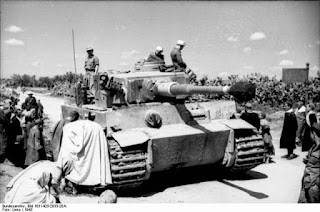 |
| German Tiger I Tunisia, 1943 (Photographer Linke, German Federal Archive). |
Nobody on the Allied side wanted to hear that distinctive rumble in the night, because they knew what they would face the next day.
 |
| Tiger ‘114’ commanded by Alfred Rubbel of the 503rd Heavy Panzer Battalion (abbreviated s.Pz.Abt. 503) (Schwere Panzer-Abteilung 503). This is during maneuvers in May 1943 near the city of Kharkiv, in preparation for Operation Zitadelle. Additional track links have been fixed to the front of the tank because you never knew when you might need them to get home (fixing them was better than walking) and they provided some added protection for that vertical glacis plate. Small modifications were continuously incorporated on armored vehicles and here included a rain guard over the binocular telescope in the gun mantlet, fitted in the field. |
One Tiger could - and sometimes did - chase an entire Allied battalion out of town. Michael Wittmann did that in Normandy.
 |
| Panzerkampfwagen VI Tigers (8,8 cm L/56) Ausf. E (Sd.Kfz. 181). Rail transport was used for all except the shortest of distances unless it was unavailable or military needs dictated otherwise. |
You could listen, from a safe location:
Boom!
Whirrrrrr.
Boom!
Whirrrrrr.
Boom!
Ja, das ist gut, Genossen, jeder ist tot hahahahaha!
 |
| German officers inspecting a new Tiger, 1943 (Wessebach, Federal Archive). |
The Urgent Need for the Tiger Tank
There are different claims as to where the idea or inspiration for the Tiger tank came from. The area in dispute is when and why the Germans began working on the Tiger, not when it entered action or anything like that.
 |
| King Tiger with Porsche turret. |
This brings up a larger point: in many areas of this field, there are very authoritative sources that will tell you completely different things. They may be correct about five things, and incorrect about four others - that's how it goes in this field. For instance, at the end of this page is a video that has lots of great facts. However, it also contains inaccuracies, or at the very least highly debatable statements (three examples: it says that the Tigers opened a corridor to the Cherkasy pocket when that is almost certainly erroneous; it states that Berlin was encircled on 20 April, when Goering is known to have driven south from Berlin after that, the encirclement date actually several days later; and it also has a very high number of lost Ferdinands at Kursk, which is the common myth, when other sources put the number much lower).

The truth is that too many Germany records were destroyed at the end of the war for them to be considered completely reliable, while Soviet records are unreliable on their face and/or falsified for political reasons, or purposefully unavailable to this day (Soviet troop numbers and weapons counts inevitably are downplayed in their own records to make every battle seem more equal in terms of relative strengths, whereas their operations always somehow ended precisely where their records indicate they were planned to end the day the operations orders were issued).
 |
| A unique photograph of the interior of a German 'Tiger' tank in the battle-field. An Obergefreiter Ladeschütze (Loader) holding a high explosive 8.8 cm round with percussion/contact fuse, inside the "Turm" (Turret) of a Panzer VI Tiger. He is from the 3./schwere Panzer-Abteilung 502, Heeresgruppe Nord during the Battles of Plaskau and Narwa in Estonia. Apparently, his name is not known. Photograph by courtesy of the grandson of the tank Commander, Oberfeldwebel Felix Würden. |
Thus, there are few definitive answers in many areas of the Tiger Tank story. If you point at some facts about Tigers and say flatly, 'That is wrong,' well, your source and everything you may have been taught about that point also might be wrong (yes, even if your professor was John Keegan himself). Information comes from a variety of sources, and in some cases, none of the information from any of them is "right." A lot of facts are simply not known with any degree of certainty. Production figures, for instance, are often lost, particularly if production continued during the chaotic final weeks of the war.
There is, shall we say, some 'conjecturing' going on due to the absence of hard data. So, we go with the best sources and leave it at that.
 |
| The Tiger at Bovington, used in the motion picture "Fury." |
If you ask the British at the Bovington Tank Museum, they will tell you with great authority that Adolf Hitler began the "Tiger Programme" VK4501 (for a 45-ton battle tank) after he read reports about anti-tank shells bouncing off of British Valentine and Matilda tanks during the
Battle of Arras on 21 May 1940. Bovington knows its Tigers, there is no question about that. They have the only running Tiger left in the world. It does make sense that these encounters illustrated the inadequacy of the Wehrmacht's standard 37mm antitank gun, which also was used on the Panzer III. Mark IV's 75mm main gun was found wanting. Since the Panzer IV was the Wehrmacht's main battle tank at that time (with lots of Panzer IIs and IIIs around), it posed a bit of a problem for the Wehrmacht that it had trouble with Allied tanks.
 |
| PzKpfw VI Tiger I from 2. SS Panzer Division Das Reich in Kursk. |
The Bovington theory implies that the Germans began working up the Tiger I in mid-1940. If so, they did not make much progress that year, at least in terms of getting plans off the drafting table.
 |
| Tiger I, Yugoslavia. If you look very closely, there appears to be a doll hanging from the barrel of the main gun. This is quite easy to miss in black-and-white versions of this shot. |
A practical aspect that supports the Bovington theory is that it does strain credulity a bit that the Germans would have been able to come up with the idea for a cutting-edge tank and had it in battle 10 months later - which would be the case with the accepted theory. It probably is the case that, as always, the designers were constantly working up new, improved plans based on technological advances and battlefield experience. The Heer just needed a reason to get the ball rolling and actually order a new tank.

My quibble with the Bovington theory is that the Battle of Arras was a one-day affair that did not stop the Wehrmacht's drive to sea in the slightest. Germans never were too worried about British armor, and they destroyed literally dozens of British tanks during that particular encounter. Experience showed that it was airpower and raw numbers that invariably made the difference when fighting the British, and that formula worked throughout the war. So, it seems a bit much for that one encounter to generate an entirely new class of tanks. A more significant flaw with the Bovington theory is that, when Hitler held a major conference at the Berghof to reform the Panzer arm in mid-February 1941, he only wanted to upgrade the main guns on the Panzer III and Panzer IV - not create new and larger tanks from the ground up. If the experiences in France had had an effect on Hitler, that would have been the time to put it into practice. Hitler didn't.

There's actual indirect proof that the Bovington theory is malarkey. On 18 February 1941, Adolf Hitler held a major conference at the Berghof with his top military advisors and tank manufacturers. He demanded that the Panzer III and IV main guns be upgraded. Field Marshal Keitel protested vigorously because he said there weren't enough trained men to do it. Hitler stood firm: find the men and upgrade the guns. The tanks themselves? They were just fine. Heck, Keitel (representing the orthodox military opinion, as the other generals always briefed anyone who met with Hitler fully before such conferences) didn't even think they needed more powerful guns (which they most definitely did, Hitler was spot on with his analysis).
That meeting is germane to this discussion because of two facts:
- Hitler did not demand a new, heavier tank such as the Tiger at this time;
- It was almost a full year after the Battle of Arras.
If Hitler had been convinced by the shells bouncing off the British tanks at Arras that he needed the Tiger tank, that February 1941 meeting would have been the time to bring it up. Hitler didn't.
My conclusion? Bovington and its running Tiger are terrific, but the Bovington theory is full of it.
It is possible, though, to square the Bovington theory regarding the Tiger with the more commonly accepted story about the genesis of the Tiger, so let's go through that exercise also.
 |
| German Army Oberleutnant Wilhelm Knauth in the turret of a Tiger I heavy tank, Russia, Jan-Feb 1944 (Federal Archives, Wehmeyer). |
While Hitler may indeed have been thinking about a new tank in mid-1940, there doesn't appear to have been a particular sense of urgency about it until much later, when the Germans finally held a competition to select a new production model. Hitler was probably always thinking about bigger weapons because, well, that was his thing. But having plans ready, and actually implementing them, are two vastly different things.
 |
| A Tiger Tank of the Schwere Panzer-Abteilung 502 is painted with tiger shark’s teeth on the muzzle brake, summer 1943, Leningrad sector near Lake Ladoga. |
The Germans only reached the breaking point with the panzer arm in Russia in October 1941; until then, their inventory of tanks (a substantial portion of which were still Panzer IIIs) was "good enough." After the attack slowed at the gates of Moscow, the existing panzers were no longer "good enough," and something had to be done. That "something" would have to be a new, more powerful tank to take on the heavy Soviet tanks. That was when the motivation mentioned above kicked in.
 |
| German Tiger Tank Commanders | Heavy tank PzKpfw VI Tiger Ausf H1 Commander Hauptmann Lange. This shot nicely emphasizes the broad tracks which were so vital for operating in the Russian snow and mud. |
So, the generally accepted understanding is that the Tigers came about as actual weapons and not just designs when the panzers were surprised by the quality of Russian tanks during Operation Barbarossa. This sudden realization happened during a specific incident in October 1941, which ironically was the height of the German onslaught and the time when the Russians themselves were most fearful. In other words, just when the world viewed the panzers as unstoppable, the Germans themselves suddenly realized they weren't.
 |
| Tigers on a barge with Panzerkampfwagen III, crossing a river. You wouldn't want to be a British or Soviet patrol boat messing with this barge! Many bridges could not support Tiger tanks. There was equipment available for them to ride on the bottom of the river, but it was seldom used. |
Stalin, it turned out, had an entirely new, secret (well, secret from the German high command, anyway) class of tanks which he held in reserve throughout the opening stages of the war. These T-34 and KV-1 tanks had been developed before the war based on plans purchased from American designer Walter Christie. Stalin had them in production for about a year when Germany invaded. However, while he had a small stockpile of them, Stalin kept these powerful new weapons away from the battlefield, in reserve, until the time was right. Amazingly, the Germans didn't even know about them.
 |
| Early Russian T-34 with a 76mm main gun. |
In October 1941, the time was right to unleash these new weapons on the unsuspecting Germans. The T-34 proved to be at least a match for any German tank of the time, which was quite a surprise to the Germans because they were quite proud of their tank arm. The Germans noted with alarm that shots were simply bouncing off the sloping armor of the T-34. What was most amazing, though, was that the T-34 wasn't even the biggest or most powerful of the new Soviet tanks.
 |
| A knocked-out Soviet KV tank. I believe this is the first one that the Germans encountered, which caused a lot of concern. |
One Russian heavy tank, a new KV (for
Kliment
Voroshilov, the Soviet defense commissar/politician), proved an even greater surprise than the T-34. In a famous incident, just one KV blew through an entire German regiment before being stopped at point-blank range over open sights by an 88mm anti-aircraft gun (one of the first such uses by this versatile gun). The KV was virtually unstoppable except by heavy artillery. Taken together, the T-34 and KV scared the Germans and forced them to reassess their entire armored force. That is what led to the creation of the Tiger I.
 |
| A perfunctorily camouflaged Tiger I waiting patiently to greet some Russians. |
The Germans knew who to call upon to get some answers. General Heinz Guderian was perhaps the leading tank expert in the world. He had written extensively before the war on tank tactics. During October 1941, Guderian was at the front leading a Panzer Army (the southern pincer around Moscow). Guderian investigated the incident involving the KV tank and figured out what the problems were with current panzers, and there were several. A bigger gun was necessary to handle the dangerous new Russian tanks, thicker armor necessary to protect the crews, wider tracks to handle the Russian snow and mud, and various other smaller details. Guderian knew tanks better than anyone, and his judgment about tanks as weapons was consistently excellent (and much better than his tactical judgment, though he was competent at that and an innovator in tank tactics). He gave his quick findings to the major tank designers, who were ordered to whip up a response.
 |
| Inside a Sturmgeschütz III. |
The designers raced around the clock to come up with an answer in both the medium tank category represented by the T-34 (then nailed down in the Wehrmacht by the Panzer IV) and the heavy tank category of the KV (of which, amazingly, the Germans possessed not a single example at the time). The medium tank that resulted by early 1943, often considered the best tank of the entire war, was the Panther. The Tiger was the heavy tank, and it was rolling by August 1942. However, first, there was a process that had to be completed before the actual Tiger design was created - which once again argues against the Bovington theory that "the" design process was set in motion in 1940. In fact, the Tiger design was not set until 1942.
 |
| Rejected Porsche Tiger P prototype VK4501 P. |
For the heavy tank, a design competition was hastily organized among the two major vehicle manufacturers, Henschel and Porsche. Porsche actually didn't have any experience building tanks, but Hitler had a lot of faith in Dr. Ferdinand Porsche himself. Prototypes were completed by both companies in record time, with major contracts awaiting the winner. The two behemoths then faced off in an extended competition (Porsche submitted multiple versions). The version chosen was the one submitted by Henschel. The final Porsche version which was rejected, however, also had an interesting history which we'll get to below.
 |
| s.SS-Pz.Abt. 101 "LSSAH", Tiger 232 northern France, spring 1944. As air attack was deadly at this point, the tank wisely is hiding amidst the foliage. (Sobeck, Federal archive). |
Hitler meddled with the design, which caused Guderian no end of frustration. The various "fixes" raised the Tiger I's weight from the projected 45 tons to almost 60 tons. Still, the engineers could handle the changes, though they did put undue strain on various parts of the Tiger's suspension, transmission, and engine. Thus, many tanks broke down on the roads. This was a consistent problem with the mid-war panzers, both the Tigers and the Panthers, which was never resolved.
The Tiger I
Once it won the heavy tank competition, Henschel began ramping up production immediately. The first Tigers started appearing on the Leningrad front in August 1942, ten months after the problem before Moscow, but there were issues. Two of the first four Tigers broke down before they got near the enemy. They were undoubtedly impressive and outclassed every other tank, German or Russian, but the first Tigers had engine and transmission troubles and many wound up by the side of the road - or, worse, in the middle of it. The Tigers were big, and towing them presented a problem all its own at first. Some teething problems are inevitable, especially after such a quick turnaround. Some Tigers appeared in Tunisia before the collapse of the bridgehead there, but many more probably wound up at the bottom of the Mediterranean in sunken Italian transport ships (fully half were sunk in the last few months) than actually made it to General Erwin Rommel's troops.
 |
| Panzer VI 'Tiger I' (231) of 2./s.Pz. Abt. 503 during 'Operation Zitadelle' in the Belgorod area of Russia. Early August 1943. The 503rd (attached to XI. Armeekorps), took part in the southern sector of Operation Zitadelle. Four days before the start of "Zitadelle," the Abteilung reported that 42 of their 45 Tiger tanks were operational. (Colourised by Royston Leonard from the UK). |
 |
| Just for comparison, the same picture in the original black and white. I think there are some advantages to both the original and the colorized versions of this kind of shot - the b/w is a little sharper. Experience shows, however, that people prefer the colorized versions. |
Hitler thought the Tigers were invincible and would win battles all by themselves as soon as they appeared on the battlefield. He liked to say "We shall put the Tigers in there and that will be enough. They are unassailable." Tiger tank crews were taken from successful crews of other panzers and put through a course at a special school. The most successful men were put in the most advanced tanks, creating an elite force.
 |
| Tiger Tank Gunnery school in Putlos, Germany. |
During the battle of Stalingrad, Hitler responded to General Manstein's pleading for more forces to rescue the trapped Sixth Army in part by noting that a trainload of Tigers was on the way and would solve everything. That was not to be, though the Tigers did have many fantastic early successes and remained fearsome to the end.
 |
| A Tiger in Tunis, 1943. |
It took time to figure out the mechanics of the great beasts and how to incorporate them most effectively into the Army. Once they were understood, though, Tigers indeed could accomplish things nothing else could - but only if used properly and under the right conditions, not by simply letting them loose and then counting the prisoners.
 |
| Two Tigers from Schwere Panzer-Abteilung (heavy panzer detachment) 503 as seen through the driver’s vision visor during an advance in the summer of 1943. |
The Tigers required full support (most importantly ready maintenance) and expert handling. If provided with these two things, they performed like high-performance racecars relative to lower-grade tanks.
 |
| The commander’s tank of the Schwere Panzer-Abteilung 503 opens fire with his main gun at Kursk in the summer of 1943. |
Tigers were too late to help at Stalingrad. However, there were a few on the way that just didn't get there quite in time - not that they would have made any difference. They helped to stop the Soviet onslaught that continued to the west after the city itself was surrounded. They proved more useful in the brilliant Manstein counter-offensive of March-April 1943.
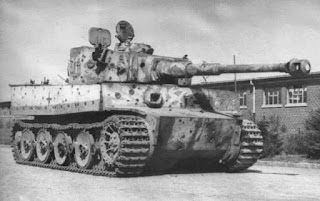 |
| Tiger ‘231’ of Leutnant Zabel from Schwere Panzer-Abteilung 503 was hit 252 times by fire from all calibers during combat near Semernikovo, on the outskirts of Rostov-on-Don on 11 February 1943. The tank was able to be driven a further 60km to the rear area and returned to the unit. Later, the tank was returned to Germany (note the transport tracks) but it is not known whether this tank was repaired. |
The most important tank battle in the history of World War II Germany, the battle of Kursk commencing 5 July 1943, was fought with comparatively few Tigers. Without getting into a complete recap of that battle, the main attacks on both the north and south faces of the converging attack each were comprised of only a few dozen Tigers, along with a roughly comparable number of Panthers. Heavy tank battalion 503, on the southern arm of the pincer attack, had 45 tigers, of which 42 were operational at the start of the battle. It operated with III Corps, with 15 tanks allocated to each of the three divisions of the corps. The Tigers performed well and enabled Army Detachment Kempf to cover the vital eastern flank of Hoth's 4th Panzer Army. III Corps only lost three tigers during the battle. It was the only part of the entire operation that could be said to have out-performed hopes and expectations. There is a tendency among some to belittle the usefulness of Tiger tanks and claim they were an extravagant waste of resources, but they were irreplaceable in such specialized operations.
 |
| Tiger tanks of 503 Heavy Tank Battalion of the Army Detachment Kempf, advancing with infantry in a Soviet village during the early days of the Battle of Kursk. |
Unfortunately for the Wehrmacht, though, the vast majority of panzers for the Kursk battle - roughly 3,000 in all, though the numbers vary widely depending upon what units you count (reserves? vehicles in the repair shops?) - were medium Panzer IIIs and IVs which no longer scared the Russians. The 45 tigers apiece of 503 heavy tank detachment in the south and 505 detachment in the north could not be everywhere. The roughly 5000 Soviet tanks they faced (including reserves), primarily T-34s, were too much to overcome in a timely fashion. Some would argue that the Germans in fact basically won the main Kursk battle, and only had victory snatched away because of Hitler's paranoid fears about the flanks and the Allied invasion of Sicily. However, Zitadelle was a dead end: the Soviets, in fact,
were massed on the flanks, and even if the panzers completed the pincer attack, they themselves could have wound up surrounded in an even bigger Soviet pincer attack that would have decided the war then and there. Hitler for once made exactly the right decision when he pulled units out to shore up the flanks, thereby preventing Soviet breakthroughs there, and then yanked the remaining mass of armor (including the Tigers) out before it could be encircled. Germany already had lost the battle of matériel with the Soviet Union by mid-1943, and that was something that superior tactics and weaponry could not overcome.
 |
| Tiger Is of the III Panzer Corps, early 1944, riding to the rescue of the Korsun-Cherkassy pocket. Notice the ones parked in the background to the left, too (Jacob, Federal Archive). |
So, as everyone knows, the Germans lost at Kursk. Tigers alone were not enough to overcome the overwhelming Soviet numbers in major strategic operations. However, in select later situations, they did make a very real difference. For instance, due to Hitler's vapid insistence on holding the last remnants of the Dneiper line south of Kyiv, 58,000 German forces became surrounded by the Soviets early in 1944. This became known as the Korsun–Cherkasy Pocket. Many thought these men were all but dead meat, just like 6th Army/4th Panzer Army had been at Stalingrad a year earlier.
 |
| Tiger I in the field. |
However, conditions were different than at Stalingrad: the weather was not as severe, the distance to the pocket from German relief forces was less, Soviet encircling forces were weaker, there were larger German troop concentrations nearby to effect a rescue, the supply situation was better, and the trapped men now knew (after Stalingrad) better than to sit around and wait for relief. Their hope was for Manstein's Tigers to cut their way through the mud and snow and the fierce Russian resistance until they were close enough for a break-out.
 |
| A Panzerkampfwagen VI Tiger I (8,8 cm L/56) Ausf. E (Sd.Kfz. 181) '332' of Schwere Panzer-Abteilung 3./503 carefully trying to make its way out of the mud. In October 1943, the battalion was in a rest area near Znamenka, Tambovskaya Oblast, Soviet Union, where it had time to maintain and repair vehicles and conduct training. This image shows recovery training that was conducted on the 4th of October 1943, but this was not some school-tank: Note the signs of an explosion that did not penetrate on the turret right behind the driver (colorized by Doug). |
After strenuous efforts and some failures by others, the Tigers alone were able to get just close enough for the breakout to the village of Lysyanka under General Stemmerman (who perished during the escape) to partially succeed. There were vicious tank firefights that prevented the Tigers from actually closing the gap, with the Soviets dug in behind a nearby hill.
 |
| Tiger on a ferry. This probably was during the evacuation of the Caucasus to the Crimea in the late summer of 1943, a highly successful operation on a par with the successful evacuation of Sicily earlier that year. That is either a Schwimmwagen or a Kubelwagen next to it. This ferry can probably defend itself pretty well against other ships, don't you think? |
About 35,000 out of 50,000 (the Soviets disputed these figures) German soldiers escaped. This was only due to the absolutely brilliant abilities of III Panzer Corps and its heavy tank battalion against the dug-in Russian artillery and tanks. Without the Tigers, the Germans all would have become prisoners and perished in Russian captivity like so many other German POWs. It was one of the most brilliant operations of the entire war, almost unknown in the West. It succeeded (to the extent that it did) only by a thread, a thread held by the Tiger Tanks. Note that the Soviets contended that only very few Germans escaped - there is no referee to settle these disputes and we must proceed on the evidence available. Commanding General Stemmerman perished during the escape, though the Germans pretended for a time that he hadn't.
 |
| SS Panzergrenadiers by a Tiger I of the 2nd SS Panzergrenadier Division Das Reich during the Battle of Kursk. They are behind a hill, ready to launch. |
The Tigers weren't always so successful. For example, in the Tunisian bridgehead, the Tigers did fairly well, but they were far from the war-winning super weapons that Hitler expected and needed. Out in the desert, they had no cover and were exposed to air attack, their deadliest opponent. In addition, desert dust caused problems.
 |
| Obersturmbannführer Christian Tychsen, 2nd SS Panzer Division "Das Reich." The 353rd recipient of the Oak Leaves and a veteran of the Eastern Front, Tychsen was killed by air attack in the latter stages of the Normandy campaign. |
While capable of handling themselves against ground attacks, Tigers had no defense against aerial attacks. More so perhaps than on the Eastern Front, where the Luftwaffe remained effective almost to the end, the best antidote to Tigers always was a well-placed air strike. When confronted by a 500-lb bomb, the Tigers became just another vulnerable vehicle.
 |
| Despite its 56-ton weight, this Tiger I was overturned by the bombing preparatory to the Allied breakout from Normandy. Three men survived. Normandy, France, July 1944. Just imagine the sheer power of the bombs to do this. |
When you see pictures of overturned Tigers, it was likely caused by air attack or perhaps a lucky hit with field artillery.
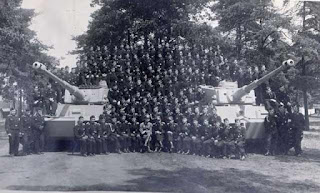 |
| Tiger tanks and crews in a commemorative pose. The tanks look new. A commenter notes that this is the newly formed 2nd Company of the sPzAbt 502 (heavy tank) unit in France. |
So, the first models of the Tigers did well enough but did not quite meet expectations of Adolf Hitler. They were powerful but had many breakdowns and losses due to the inexperience of the crews. This was only normal after their rushed design and production, as all tanks have initial teething problems. Nobody lost faith in the basic design, though, and modifications were made.
 |
| German Panzer VI (Tiger I) in front of the Fascist Vittoriano (Altar of the Fatherland, later the Monument to Victor Emanuel II). Rome, Italy first half of 1944. |
As their development progressed, the Tigers were modified to meet changing threats. It was found, for instance, that magnetic mines thrown at Tigers and other tanks were a danger. The Germans came up with Zimmerit, an anti-magnetic paste developed by Chemische Werke Zimmer AG. This prevented magnetic mines from sticking to the tanks' hulls and disabling them.
 |
| A British soldier hiding from the rain under an overturned Tiger tank. Italy, 1944. Tigers sometimes wound up like this after they were left in the middle of a road and convoys coming later - usually the Allies - had to shove them off the road any which way to get by. |
However, Zimmerit added two days to production, which was unacceptable at a time when Germany was fighting for its life. In addition, there was a false fear that the paste was flammable and would catch fire. The fear of magnetic mines was overblown anyway. Zimmerit thus was discontinued in late 1944, but it did its job and is the wavy substance seen on many tank pictures from the period.
 |
| General Eisenhower passes by a smashed German Tiger tank in the vicinity of Chambois, France, on August 23, 1944. The general is without a close security escort, a routine occurrence as Ike did not like being "crowded." Still, this photo was taken very close to German lines, and it illustrates the Tigers' incredible size. |
After some re-working and minor upgrading of the underpowered engine from 650 to 700 Hp, Tigers became the preferred weapon of the German tank specialists. The eternally capable Panzer IV and the deadly Panther remained the most common German designs on the battlefield through the end of the war, but the tankmen themselves aspired to a Tiger or Tiger II mount.
 |
| An American Soldier sits in the Turret of a knocked out Tiger Tank, possibly 1944 in Normandy. The soldier is emphasizing the immense size of the turret, which has been blown clean off the body, most likely by air attack (colorized). |
While the other tanks were distributed throughout other formations, only the Tigers were organized into their own discrete formations. These were called Heavy Tank battalions (Schwere Panzer-Abteilung) and remained under the direct command of higher army leadership, often Hitler himself. Hitler, in fact, was known to keep close tabs on the movements of Tigers by rail, knowing exactly where they were in their journey to the Front.
 |
| Soviet T-34 medium tank beside a Tiger I heavy tank. |
Tigers were to be used only at key points to achieve decisive results. They were operated by reliable (fanatical) SS Troops, who invariably got the best equipment whether they deserved it or not.
 |
| Tiger I commander scanning for targets, most likely at Kursk. |
The Tiger I was a deadly opponent with the famous 88 mm gun serving as its most fearsome weapon. The 88 (as it was universally called) originally was an anti-aircraft gun that had limited maneuverability, but once it became mobile on a Tiger, it was positively fearsome.
 |
| s.Pz.Kp./SS-Pz.Rgt. 2 "Das Reich", two unidentified Tigers and a StuG III move forward during Operation "Zitadelle", the Soviet Union, July 1943 (Canticler, Federal Archive). |
Tigers did have their share of design problems. First, their front glacis plates were vertical, making them more vulnerable to return fire than was necessary. Instead of bouncing off sloped armor, enemy shots stuck - and thus more often pierced the armor than necessary, which meant death for everyone inside.
 |
| A column of PzKpfW IV Ausf.G and Tigers of the 2. SS-Panzer-Division 'Das Reich' marching through a snowy forest, near the city of Kirovohrad, 250 km southeast of Kiev, to combat the forces of the 1st Ukrainian Front. Ukraine. 1 December 1943 (Schnitzer, Federal Archive). |
The designers' decision to ignore a principle that had been known at least since the US Civil war 80 years earlier - that sloping armor vastly increases its defensive properties - and which was a key feature of the dreaded T-34, is simply odd. There may have been some over-confidence in the intrinsic power of the Tiger at play there. This glaring design fault was not corrected until the Panther and Tiger II came out.
 |
| Note the snorkel tube on this Panzer VI Tiger I, being tested post-war. Being too heavy for some bridges, the Tigers were designed from the outset to cross rivers underwater. There is not much evidence of the snorkel actually being used, though, as the Tigers went over most rivers by train or sturdy military pontoon bridge. |
Tigers also were too heavy for many bridges of the day, so - incredibly - they were fitted with snorkel tube and driven underneath rivers rather than upgrade the many bridges of northern Europe. In the event, the Tigers were treated so carefully that the bridge issue never received much notice.
 |
| Abandoned (knocked out) Tiger and Panzer IV of Panzer Lehr, Villers Bocage, France, 1944. When defending cities late in the war, the tactic was to place available tanks at intersections and await the enemy. There are pieces of them scattered all about, must have been a big explosion. A commenter notes that these Panzer IV and Tiger "112" (Oscha Ernst) were knocked out by a Sherman Firefly at Villers Bocage on June 13, 1944. |
Tigers weren't very fast because there were no engines powerful enough to move 50 tons of deadweight at a fast clip. When they did move, they burned a lot of gasoline (no existing diesel engines were powerful enough to propel the monsters).
 |
| PzKpfw. VI Tiger near the river Orne in Normandy, 1944. A commenter notes that this was SS PzAbt 102. |
Their original 12-cylinder Maybach gasoline engine developed only 650 HP at 3000 RPM, which may sound like a lot, but is insufficient to move that much weight around very quickly. Henschel tinkered with the engine and slightly upgraded it to 700 HP, but the Tigers remained slow and ponderous until the end of the war. They could roll along at roughly 20 mph.
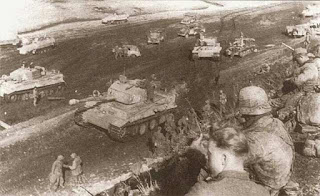 |
| Soldiers admiring Tigers of sPzAbt 507 in an assembly area near Ternopil, April 1944. Note the battalion HQ command tank marked "A." Thanks to a commenter for identifying this scene. |
The Tigers' great weight also made them difficult to recover on a fluid battlefield when they lost a tread or had some other fixable problem. Usually, another Tiger wound up towing them back to a repair shop. However, many that could have been recovered had to be left behind, especially later in the war when the Germans were on the run.
 |
| Villers Bocage, Summer 1944. Villers Bocage was a key road junction that was fought over desperately. Here, Tiger tank 231 is getting towed by tank 222 after a breakdown. Ten days later, 231 was abandoned and scuttled in the middle of a road by its crew after it ran out of fuel. Tiger tank 231 was saved and is still around today. That is SS Untersturmfuehrer Hantusch in the motorcyclist overcoat (colorized, and thanks to a commenter for the commander's ID) |
Self-help was often the answer. It was not unknown for crews to carry spare tracks into battle and then work like mad to try and replace their own tank treads after one was blown off. The tracks and engines had to be replaced with regularity, treads every 200 kilometers or so, though that was a problem with all tanks of the period. The turrets also turned too slowly, a fact the Allies discovered and exploited with agile weapons such as the 76 mm Gun Motor Carriage (GMC) M18 "Hellcat" tank destroyer.
 |
| s.Pz.Abt. 508, a 2.Kp. A Tiger having work done near Aprilia, Italy, February 1944 (Vack, Federal Archive). |
Even with all their problems, Tiger Tanks was the king of the battlefield. The standard rule of thumb was that it took five standard American medium tanks (Shermans) working together to overcome one Tiger I. This was borne out by experience many times. The typical reaction was for Shermans to call in heavier equipment to deal with the Tiger if such were available.
 |
| German Panzer column comprising Tiger tanks of 506 Heavy Tank Battalion join the retreat of the German army in western Ukraine on May 4, 1944. |
Indeed, five Shermans is what it took finally to overcome Panzer Waffen SS Captain Michael Wittmann in his Tiger in Normandy. Wittmann had been on a bloody reign of terror against the Allies since the invasion, single-handedly stalling the invasion of France with his fighting prowess at Villers-Bocage on 13 June 1944 and on other occasions.
 |
| Wittmann and his crew, who have quite a collection of medals by this point. |
Wittmann was a veteran tank commander with an experienced crew who knew what he was about and what risks he could take. Tanks are just hunks of useless metal without good crews. Wittmann and his men were among the best.
 |
| The driver's seat of a Tiger, shell loading to the right. |
At Villers Bocage, southwest of the key city of Caen, with his veteran crew in his single Tiger Tank on 13 June 1944, Wittmann established his legend once and for all. In a famous sequence, while in command of his unsupported Tiger tank in the middle of this key crossroads village being invaded by the British, Wittmann destroyed 14 enemy tanks and 15 APCs and other enemy equipment in 15 minutes.
 |
| German tank ace Michael Wittmann's company, 7 June 1944. They are on road route Nationale 316 en route to Morgny. Wittman can be seen standing out of the top turret hatch on the lead Tiger I tank #205. Does it need to be said that these were propaganda photos? They were propaganda photos. |
Wittmann just waltzed into town while his mates waited undercover and started blasting everything that moved, exactly as you see it in the movies. The British had to turn tail and literally head for the hills as the rest of Wittmann's SS Heavy Panzer Battalion 101 moved in to finish the job. The British had nothing to match the Tiger except antitank weapons and courage. This was one of the scariest 15 minutes of the war for the soldiers opposing him, many of whom died that day. It also contained the entire invasion force, which otherwise likely would have broken out into France weeks earlier. Wittmann earned and received a promotion that day, and the Tiger Tank proved its worth - again.
 |
| During the Battle of the Bulge, Kampfgruppe Peiper led the way. It was boosted by the King Tiger tanks of the Schwere SS-Panzer-Abteilung 501 for its drive westwards in an attempt to reach the Meuse River. It fell just short. Here, one of its tanks, on its way to Lanzerath in the initial breakout, passes a column of captured soldiers from the US 99th Infantry Division marching toward Germany. |
A couple months later in August, as the Allies were breaking out of Normandy, Wittmann, in turn, was killed by the British and Canadian tankers. Riding high in April, shot down in May... Certainly, Wittmann had faced odds of a similar nature on the Russian front in the past as he ultimately faced in his final battle, and worse odds, too - but everyone gets unlucky after too many brushes with death. There are some that say he actually was reckless and needlessly exposed his flank both during earlier engagements and in the course of his final confrontation. That may be true, but he was tough and brave and quite successful for a long time. He was not going to allow the enemy to invade his country, not while he still took a breath. The increasing odds against him and accumulation of risks from his aggressive style just finally caught up with him.
 |
| Wittmann in command. Note all the prominent Zimmerit paste. |
The British finally caught Wittmann in a flank attack with five Shermans against his lone Tiger, and it was too much. Very few on either side matched his skill as a daring tank commander, but the preponderance of forces against him was impossible to survive forever. Wittmann killed a lot of good men, but he did so in an honorable fashion, following the rules of war, and earned the respect of many of those who survived. Of course, some will never forgive anyone who fought on the German side, and that is understandable.
 |
| Wittmann receives his decoration and promotion for his actions at Villers Bocage. |
The biggest enemy of a German heavy tank such as the Tiger wasn't an enemy tank, or even a group of enemy tanks, though a mass of tanks could be deadly. It was an air attack, against which Tigers were defenseless. One plane dropping a 500 lb bomb with precision could destroy any tank.
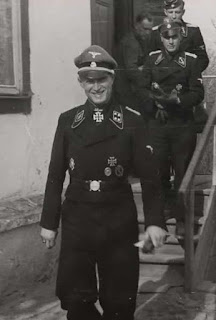 |
| 2nd SS Pz.Div. "Das Reich" officers: SS-Sturmbannführer Christian Tychsen, SS-Obersturmführer Hans Pavelka and Untersturmführer Karl-Heinz Worthmann. |
Of course, the Luftwaffe Stukas also destroyed a lot of Russian tanks and would have done the same in the West if the balance of air power had been more equal there. But the 11,000 Allied planes covering the Normandy battlefields established absolute control of the air and created the "German glance" - a look back over the shoulder to see if an enemy plane was about to make a strafing run.
 |
| You lookin' at me? A Tiger I. |
Tiger II, or "King Tiger"
With actual experience from the battlefield of the Tiger I, and further developments in enemy tanks, the German tank designers continued upgrading their tank plans. The problems of the initial version of the Tiger were recognized and major changes were made. However, there was only so much that could be done with the technology of the day.
 |
| Tigers. You don't like us? Screw you. Come and get us. |
The Jagdtiger Panzerkampfwagen Tiger B/Panzer VII/ Panzerkampfwagen Tiger Ausf. B was the result. It is also known as the Königstiger (Bengal Tiger, its literal translation) or more familiarly as the "King Tiger." We go with "King Tiger" because that is what everyone uses and recognizes, even if not correct under a hyper-technical definition.
 |
| Königstiger - King Tiger tank beside a Sherman tank. This illustrates quite nicely how the Sherman, despite its defenders, was from a much earlier generation of tank design. The rule of thumb was that it took five Shermans to destroy a Tiger tank, otherwise the Shermans would be destroyed. Be honest with yourself - which would YOU prefer to go into battle in? |
The King Tiger could carry up to a 128 mm PaK 44 L/55 main gun, capable of out-ranging and defeating any Allied tank (or just about anything else). Some apparently mounted the 88 mm, just like the Tiger I. Only 492 King Tigers made it to the field starting in September 1944, as compared to 1347 Tiger I Tanks.
 |
| PanzerKampfWagen VII, The King Tiger Tank. |
Many Tiger IIs were lost due to lack of fuel or when untrained crews damaged the sensitive transmission. It was invariably too heavy to be recovered, and many were left behind as the Germans retreated. However, on the field, they destroyed everything in sight and could only be damaged by aircraft or heavy artillery.
 |
| Kurt Knispel was another Tiger tank expert. In fact, Knispel was the best tank expert in the world. Knispel was a Heer tank commander in World War 2. With all due respect to Michael Wittmann, this is the man who many consider the greatest tank ace of all time. He destroyed 195+ enemy tanks on all fronts of the war, one a T-34 from 3000 meters (which required quite a fancy ballistics calculation). He fought on all fronts and was the leading expert with the Tiger tank. He fought in many major and hopeless battles, turning the tide at the last minute at Caen and Cherkassy. He never made it past Sergeant because he fought with the hierarchy all the time and they despised him. He was KIA at the end of the war, April 28, 1945. |
Clearly, the Germans had a thing for huge weapons, which usually didn't work out well for them. However, as mentioned above, they were just responding to their opponents. There was nothing unusual about formations of heavy tanks in the Russian or British armies, but nobody ever talks about them as being wasteful. The only thing unique about Tiger Tanks was their renowned deadliness.
 |
| Tiger II abandoned during the failed Peiper counteroffensive. |
Based on the economic realities of the time, the Germans had no hope of matching the production abilities of the forces arrayed against them, so they had to try for a qualitative edge.
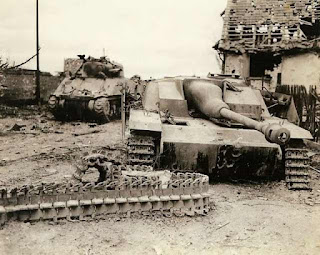 |
| Knocked out American M-4 tank and German Sturmgeschütz IV sit side by side in the street. Photo courtesy of the estate of General Charles Day Palmer, a United States Army four-star General. |
It was a pretty hopeless strategy, but it was all they could do. In a one-on-one collision of a Tiger and a Sherman, the Sherman was at a huge disadvantage; but such confrontations were not the norm. More often, it would be several Shermans against one Tiger.
 |
| King Tiger II. |
This they managed to achieve with the Tiger I and II. Even then, they were just slightly ahead of their enemies. The Allies were busy designing and building tanks that were almost as large and deadly and, in one or two cases, more so.
 |
| Mud recovery training of sPzAbt 503 (heavy tank company, see another photo of the same scene above). Ukrainian fields are crisscrossed with these crevasses at regular intervals, many much deeper than this. Some you can cross, others you get stuck in, so recovery training was essential. |
Handled by a pro like Wittmann or Knispel, a heavy tank like the Tiger - well, the Tiger and in particular the Tiger II - could be the most formidable weapon on a battlefield and change the course of events all by itself. This did happen many times, such as when Wittman and his mates beat back a British regiment at Villers Bocage.
 |
| Captured Tiger II, south of Bastogne, January 1945. |
The Tiger II was actually much closer to the dominating weapon that Hitler sought than any other super-weapon such as the V-1 or V-2 rockets.
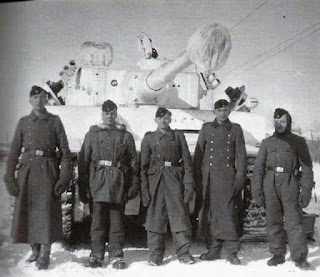 |
| The proud crew of an early Tiger in Russia, late 1942. |
A weapon is only as good as its crew, and the Tiger IIs had some of the best: Kurt Knispel, Johannes Bölter, Ernst Barkmann, Otto Carius, and Michael Wittmann.
 |
| King Tiger (Tiger II) Jagdtiger ("Hunting Tiger") tank destroyer with a young crewman, perhaps in the Hitler Youth Division. This was the heaviest tank destroyer of the war and the heaviest tank ever to reach series production. This bad boy was big. You don't think of little kids like that in one of them - but they were at times. Note that in this version, the turret was part of the cast-iron frame and could not move. |
There simply were never enough of them or sufficient fuel and resources to adequately supply them for the Tigers to make a decisive difference. Towards the end, tanks were even going into battle without even a full "basic load," or full supply of fuel and ammunition.
 |
| A nest of King Tigers - not something the Allies looked forward to fighting. |
Ferdinand/Elefant
The Porsche heavy tank which lost the heavy tank competition to the Tiger still went into service despite having only a very limited production run. It initially was called the Ferdinand in honor of Porsche company leader Ferdinand Porsche. The common name later changed to "Elefant" after some upgrades because of the weapon's distinctive profile. An easy way to remember the name change is that the tanks had the name "Ferdinand" while operating on the Eastern Front, and then "Elefant" after being transferred to Italy.
 |
| This Elefant has hit a mine during operations against the Allied beachhead at Anzio-Nettuno. It was part of the 1./653 (1. Kompanie of Schwere Panzerjager-Abteilung 653) (Federal Archive). |
Only about 88 Ferdinands were made, and all were used in the northern sector (Model's sector) of the Kursk battle. The Soviets feared the Ferdinands and made special note of their presence. In fact, they thought the southern (General Manstein and SS General Hausser) wing of the Kursk attack had the Ferdinands when in fact it had none. This fear factored into their battle plans, an example of "psyching out" your enemy before the first gun is fired.
 |
| A captured Ferdinand being inspected by Allies. |
General Model had no success in his sector at Kursk, and the Ferdinand was his "secret weapon," so the Ferdinand developed a bad reputation early on that has stuck with it. However, that reputation is unjust. It is true that the Ferdinand was an enigma of a weapon. The Ferdinand was prone to breakdowns, caught on fire frequently, was slow and had no defensive machine gun. As such, in offensive roles, the Ferdinand was a disaster. Many were destroyed before even reaching the front line, and if a Ferdinand outran its infantry support it was doomed; with no secondary armament, the Soviets could run over and attach mines to it or simply pour gasoline over the engine vents and set it on fire. Some 39 were lost in Kursk, many to mines, others to Russians sneaking behind them. Once disabled, a Ferdinand became sitting ducks for air attack or artillery. This didn't happen nearly as often as later legend would suggest, but that it could and did happen at all was not a good sign for the Ferdinand. Tanks that couldn't operate independently required a lot of support, which was hard to come by as German forces dwindled.
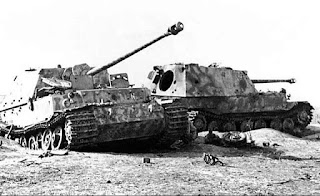 |
| Destroyed Ferdinand tanks. |
As a defensive tank in Italy in a properly constructed combined-arms operation with adequate defending ground troops and artillery, every Ferdinand became incredibly effective. On average, they destroyed 355 enemy tanks for every Ferdinand lost (some say it was only 10:1, which is still the best ratio for a class of tanks in history), making it the most successful tank killer of the war. At least, that is the claim that some make, and who knows if that is accurate, but it sounds good. Anything like that would be quite an achievement, certainly a better ratio than the fabled Tiger.
 |
| Tiger column, north of France. A colorized shot from the same movement is below (Scheck, Federal Archive). |
The fact that the Ferdinands were withdrawn from the Russian Front made many later authors assume that they were complete failures. That is far from the truth. Hitler also intended to transfer other formations to Italy at the same time because of the Allied invasion of Sicily. These transfers did not signify failure, in fact, Hitler chose elite formations such as the Leibstandarte Division. However, the transfer actually worked out well for the Ferdinands (now called Elefant), because the mountainous and woody terrain of Italy was ideal for their deployment as defensive tank killers. Air attack also was not as much of a problem in the Italian mountains with some ground cover.
 |
| This color shot shows the camouflage. It is a column of three German heavy tanks “Tiger I” of the 101st Heavy Tank Battalion of the SS. They are running along road 316 to Morgny (Normandy, France), June 7, 1944. The commander of the tank closest is Unterscharführer SS Ewald Möli. This battalion was home to tank ace Michael Wittmann, known for his Famous 13 June solo attack in the battle of Villers-Bocage, where he destroyed a large British force. |
Despite their record of success, production of the Ferdinand was never restarted, perhaps because Porsche now was busy with the even larger Maus. However, if imitation is the sincerest form of flattery, the Italians flattered the Elefant by designing their own tank destroyer, the Semovente 105/25, that had a somewhat similar silhouette with a stronger main gun. If nothing else, this confirmed the wisdom of using the Elefant in the mountainous territory of Italy, where they weren't as conspicuous, rather than the featureless Russian steppes.
 |
| Italian Semovente 105/25 tank destroyer commandeered by German forces, Southern Italy, autumn 1943. The best Italian AFV of the war with its powerful 105 mm gun, only some 30 had been built by the time of the Italian surrender. The Germans thought highly of them and managed to build another 60, so the total production run was roughly the same as for the Elefant. |
The Elefant did its job in Italy, but eventually were all knocked out and left behind on the battlefield, to be taken to the scrapyard after the war. Only two survive, one in Moscow, the other in Virginia.
Panzer VIII "Maus"
The German tendency toward Gigantism in their weapons gathered speed as Germany started losing the war. As discussed above, there were valid reasons for it at times. The Germans understood their industrial base and what it could achieve, but they still sometimes made the wrong choices.
 |
| Maus V1 passing a KV-2 captured in 1941. The Soviet tank is demolished by several shots from AT guns and hollow charges, apparently used as a target to test weaponry. This is at the test fields of Kummersdorf. Note the Maus has no main gun and is still early in development. It also seems to be quite a bit behind the Soviet tank, the perspective makes the Maus look smaller. |
The Panzerkampfwagen VIII Maus (Mouse) super-heavy tank was a poor choice. It came along very late in the game and was slated to be the heaviest tank in the world.
 |
| The Maus was not even the biggest self-propelled gun being developed at the end of the war, but it was pretty darn big. |
The Panther and Tiger, both worthy tanks, had come about on the recommendation of Panzer expert General Heinz Guderian after his close study of captured Soviet tanks. Guderian was not always the most capable strategist, but he was absolutely the world's expert on tanks. There wasn't a man alive who understood tanks and their capabilities better than Guderian. The Panther and Tiger worked and were battle-winning weapons, a tribute to having the right man making the proper recommendations at the right time.
 |
| A Maus on the move, note its tracks in the snow and winter camouflage. It looks like a pretty easy target unless it was pointing its gigantic main gun at you |
Guderian, though, had absolutely nothing to do with the development of the Maus, and it showed. Ferdinand Porsche had lost the competition for the heavy tank to Henschel, and he was devastated after all the work his company had put into it. Being buddies with Hitler, he suggested to him a couple of months later that what Germany needed was an even bigger tank, one that he had a head start on designing due to his work on the Ferdinand. Hitler, a fan of big weapons, agreed.
 |
| Tiger VIII Maus. |
Work commenced, but this time Porsche, facing no competition, took his time. It wasn't until May 1, 1943, that he presented a wooden mock-up of his super-heavy tank. It was colossal, and Hitler loved it instantly. Guderian, however, noted in his post-war memoir "Panzer Leader":
On May 1 a wooden model of the "Maus", a tank project of Porsche and Krupp, was shown to Hitler. It was intended to mount a 150 mm gun. The total weight of the tank was supposed to reach 175 tons. It should be considered that after the design changes on Hitler's instructions the tank will weigh 200 tons. The model didn't have a single machine gun for close combat, and for this reason I had to reject it. It had the same design flaw that made the Elefant unsuitable for close combat. In the end, the tank will inevitably have to wage a close combat since it operates in cooperation with the infantry. An intense debate started, and except for me, all of the present found the "Maus" magnificent. It was promising to be exactly that, a "giant".
The thing was
big. A 150 mm gun is
massive. Despite all of Porsche's technical innovations, it also hearkened back to an earlier era of tank construction. During World War I, the German tanks had tended to resemble castles, including just about everything but moats. The Maus as finally developed had a mortar for close-in defense and actual portholes, like the windows of a castle, for the crew to fire rifles through. It was an insane, completely unrealistic project which would have drawn air attacks like honey draws flies.
 |
| The only operational or completed Tiger VIII Maus. |
With Hitler's (but not Tank Inspector Guderian's) approval his, Porsche quickly put together a couple of partial prototypes (V1 and V2). One was completed by March 1944, but the war was going badly and the German hierarchy faced reality and stopped all production of the fantastical weapon by August. It was a question of "Well, we have this big thing... now, what do we do with it?" On his own, Porsche continued working on the weapon, putting in an engine and otherwise making it functional. It remained at the Kummersdorf testing ground until the final days of the war, when the OKH ordered it their headquarters at Zossen south of Berlin for defensive purposes. There is no record of it actually fighting (it may have), but the Russians blew it up just to make sure.
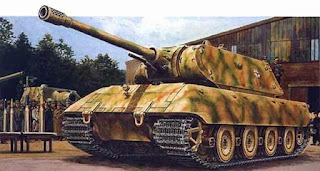 |
| Tiger VIII Maus. |
By combining surviving pieces of the two versions, the Russians managed to put one back together after the war, and it remains on display in Moscow. The Maus retains a deep fascination for some because of its uniqueness. In retrospect, it is not as big as legend would suggest, on a rough par with the KV1 (see picture above), though a bit bigger.
 |
| Maus - the second prototype captured by the Soviets. |
On April 11th, 2014, WarGaming announced that they will co-operate with the Kubinka museum in Moscow to restore this sole remaining Maus to working condition. Considering it barely worked in the first place, that should be some chore.
Geschützwagen Tiger für 17cm Kanone 72(Sf)
 |
| Hull of 17cm Kanone 72 (Sf) Geschutzwagen Tiger - German prototype of a self-propelled gun with 17 mm cannon. Only the hull and wheels were built. |
The Maus was not the only massive German tank project that was nearing completion as the war ended: a modification of the Tiger II to fit a much larger gun was well along the way, too. The official designation was: Geschützwagen "Tiger" fur 17cm K72 (Sf), fur 21cm Mrs 18/1 (Sf) und 30,5 cm GrW Sf I-606/9, or "GW Tiger" for short.
This was a heavy self-propelled gun. Tank destroyers without moving turrets such as the Stug were all the rage as the war dragged on, because turrets were complicated and expensive, and you could get 80% of the value of a tank at a fraction of the cost. Turrets also were a supply bottleneck, requiring all sorts of precise moving parts such as numerous ball bearings.
 |
| Rearview of GW Tiger. |
Not much is known about the GW Tiger, but it was quite real. On May 6, 1942, the Krupp firm received an order for heavy self-propelled guns based on the Tiger II. Work progressed for the remainder of the war, but no final version could be readied before the defeat.
Krupp developed the running gear to use in other projects. A preliminary plan of the GW Tiger, which received the official designation Geschutzwagen Tiger, was ready in early 1943. It was planned to use the self-propelled undercarriage of the Tiger II with an engine capacity of 650 hp - the same used in the Tiger, though that was upgraded to 700 hp later. It was to use a Maybach engine and an Olvar transmission. The main armament was planned as a massive 170-mm gun 17 cm Kanone 72, which could send the 68-kg projectile at a distance of 25,500 meters, or perhaps even a 210-mm howitzer (21cm Morser) with a range of 111-kg projectile about 17,300 meters. The maximum angle for pointing both types of guns in the vertical plane was from +65 ° to -5 °, with a horizontal angle for pointing of 360 °. In view of the large size of these weapons, the tank would only be able to carry 5 rounds as a full load.
For comparison, the Tiger II had an 8.8 cm (88 mm) KwK 43 L/71 gun. So the GW Tiger would have been a massive step up in firepower, along with everything else. It was another manifestation of the "gigantism" which appear in many late-war German designs.
 |
| American soldier surveying the hull of a GW Tiger. |
There were also projects to install on the same Tiger II chassis a 305-mm mortar Skoda GrW L/16, and even a 420-mm mortar. These never left the preliminary sketch stage. It would have been like putting a naval gun on a self-propelled platform, on a par with "Gustav" and "Dora." Sheer fantasy.
The crew of the GW Tiger would have consisted of eight people: a driver, gunner, commander, gunner and four ammunition handlers (the shells being so huge).
Krupp scrimped on the armor in order to save weight and precious nickel: maximum armor thickness was 60 mm in the front of the chassis, compared to the Tiger II's 185 mm. That would have been justified because this was a weapon to stand back and blast away, not get in the thick of the battle. Fighting weight of this self-propelled guns was estimated at 60 tons, roughly the same as the Tiger II.
 |
| American soldiers inside the prototype GW Tiger hull. |
There was no handy name for the GW Tiger such as "Maus." Unofficial names such as "Elefant" usually came about after some use by ordinary troops. However, some people referred to the GW Tiger as "Gerät" ("The Device"). It also sometimes is referred to as the "Grille Königtiger" or "Grille" auf Pz.VIB ("Cricket"). Okay, that is an odd and very unwarlike name, but informal names often are, well, informal (such as "Humpback" for an Italian bomber).
The layout and construction of the prototype body on the Tiger II chassis was completed, as the pictures show, but that was it. In February 1945, on the orders of the Minister of Armaments Speer, all work was stopped. The Allies came into possession of the unfinished hull and scrapped it.
There were other, larger projects, but they existed only on paper and were canceled much earlier.
German Propaganda and Problems
 |
| Operation "Citadel", June 1943: A Tiger I tank, turret number 114, is being towed by tank recovery vehicles. Note that it takes two tractors to move the behemoth at crawling speed. |
The Germans were superb propagandists, and they published many pictures and films of massed tank formations. They made the Wehrmacht appear as though it had vast fleets of Tigers just waiting to take on the puny Soviet and American tanks. The truth, though, is that Tigers were relatively rare even at decisive battles. For example, in the Battle of Prokhorovka, the decisive moment on the southern sector of the Kursk attack and the end of Germany's hopes of conquest, only 15 Tigers were involved. They did fight very well, slaughtering the Soviet tanks they encountered and losing only one of their own number. In fact, they enabled the Germans to effectively win the battle and retain control of the battlefield so they could recover their damaged tanks. But 15 tanks, no matter how good, along with inferior supporting German forces simply were not enough to overcome the entire Soviet army. As one German General once signaled to headquarters, they were killing Russians at a 5-1 ratio, but the Russians had started out at a 10-1 advantage. The German defense was doomed, but the Soviets did lose heavily.
 |
| Panzer VI 'Tigers' - Tarnopol, Ukraine - April 1944 (colorized). |
The Germans had the advantage of land routes to their battlefields, so shipping space was not an issue for them (as it was for the Western Allies). In addition, it is easy to forget that the Allies were coming along with their own monster tanks, such as the Pershing and the Soviet JS-2 heavy tank. The Soviets had huge tanks from the start of the war - they may not always have been effective commensurate with their size once the Germans figured them out, but they were big and powerful, certainly bigger than the Panzer IV which was the main German battle tank.
 |
| A Tiger and its crew. |
The Germans, invading Russia with a tank fleet it mistakenly thought was supreme, had to respond to the larger and more powerful tanks of its enemies (Hitler later made some noises about how he wouldn't have invaded in the first place had he known about Soviet tank capabilities, but that was likely just hot air). This explains their sudden decision during the war to leapfrog the competition and develop much larger weapons than the Western Allies. The Soviets and the Germans played tag throughout the war regarding who had the better equipment, but on the Western Front, there was no dispute about whose was better. There is absolutely no question that the average German tank was many times better than those of the Western Allies. There very few (only about 20) of the late-war American Pershings that entered the ETO conflict, and they were comparable to the Tigers. It is fair to say that both the Americans and the British were a generation behind the Germans in tank development. The British never developed a really fearsome tank (though the Fireflies were damned scary if one was coming at you). With fewer natural resources (oil, steel, men) than their enemies, the German decision, right or wrong, was made to overcome quantity disparities with quality. In the case of the Tigers, this worked and was absolutely necessary. Building ever-bigger weapons did not work in many other areas, such as railway guns and ships, but in this field, it did.
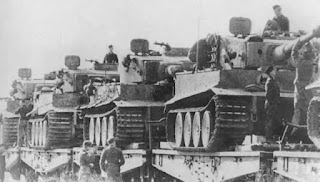 |
| Tiger tanks on their way to the Kursk salient, 1943. |
A few final words on the "size" issue. The Germans were not, contrary to what many wish to believe, stupid. They knew that bigger was not always better. The Luftwaffe, for instance, canceled its heavy bomber program in the 1930s because Herman Goering and his subordinates knew that the German industrial base was not prepared to produce four-engine bombers. Instead, they concentrated on making more medium bombers. That decision to go small worked in the early Blitzkrieg stages of the war, but somewhat ironically later turned out to be a mistake and was an area where bigger size really would have helped the German cause.
 |
| Tiger Tank 222 on the ferry crossing the straits of Messina. The evacuation of Sicily by the Germans in August 1943 was one of the most under-appreciated evacuations of the entire war. All of General Hans Hube's troops got away to fight again on the mainland - and they fought hard when they got there. |
Artillery was another area where size was an issue. While there were some notoriously huge artillery pieces in the Wehrmacht's arsenal, the army's top commanders understood reality and did not favor those weapons. They consumed too many resources, were ponderous on fluid battlefields of the era, there weren't proper targets for them anyway, and after all the effort of constructing them, they would only become magnets for air attack anyway.
 |
| King Tigers on the move. |
Still, despite the fact that the military itself didn't want them, it wound up with the war's biggest guns. Originally designed with an eye to the Maginot Line, that reason disappeared with the quick conquest of France. The German Generals then went to great pains to find some uses for them, and indeed they were used with effect at Leningrad, Sevastopol, and Anzio. The largest artillery piece - the infamous Dora gun - cost 7 million RM. The Russians also were prone to massive weapons, as one look at their airplane development during the 1930s (
e.g., the Kalinin K-7, the Bolkhovitinov DB-A) and some of their tank designs (the KV, the Stalin) shows. If there were any natural inclination towards huge weapons, that was common across countries. And Hitler just had a thing for big guns. But his dreams were bigger than anybody else's.
Sturmtiger
 |
| Sturmmörserwagen 606/4 with 38 cm RW 61, or "Sturmtiger." The Sturmtiger was an assault gun built upon a Tiger Tank chassis. Imagine a rocket coming out of that in your direction. |
Some weapons systems have fearsome names that greatly exaggerate their actual influence on events. Such is the case with the Sturmtiger.
 |
| The Tiger-Mörser, 38 cm RW61 auf Sturm (panzer) mörser Sturmmörser Tiger or Tiger, best known as Sturmtiger or Sturmpanzer VI. It was a German assault gun of World War II, built from Tiger I chassis and armed with a naval SturmMörser RW61, a howitzer, 5.4 L 380 mm. Its main task was to provide fire support to infantry troops in urban combat. Only 19 units were manufactured from damaged Tiger tanks. |
Sturmtiger (German: "Assault Tiger") or Sturmmörserwagen 606/4 mit 38 cm RW 61 was a World War II German assault gun built on the Tiger I chassis and armed with a large 380 mm Raketen-Werfer 61 L/5.4 rocket launcher. The official German designation was Sturmmörserwagen 606/4 mit 38 cm RW 61.
The Sturmtiger's primary task was to provide heavy fire support for infantry units fighting in urban areas. It was designed as an offensive weapon at a time when the Germans were in full retreat. The few vehicles produced in September - December 1944 fought in the Warsaw Uprising, the Battle of the Bulge and the Battle of the Reichswald.
 |
| Interior of a Tiger. |
Two units were attached to 6th SS Panzer Army to recover or destroy the famous Bridge at Remagen. The bridge ultimately did collapse, but due to the combined effect of all attacks on it, not just those of the Sturmtiger. About 18 or 19 Sturmtigers were completed.
German Fantasy Tanks
German industry always had a full staff of designers coming up with fantastic concepts that stretched the limits of imagination. There were several practical reasons for this:
- Existing concepts were always kept updated, which was the case with every army, and extending ideas in new directions to their logical conclusions kept the designers thinking, sort of like doodling;
- Original ideas sometimes were worked on with a company's own dime. Heinkel, for instance, worked on a jet fighter throughout the war without Luftwaffe support in hopes that the Luftwaffe would show some interest - but it never did. At some point, a prototype would be shown to Hitler during his occasional visits to the testing grounds at Kummersdorf or Rechlin, with the possibility that he might be impressed enough to order them. This was a speculative practice that usually led nowhere but occasionally led to massive contracts.
- The designers needed to look busy, else the Russian Front beckoned.
Thus, the Luftwaffe designers came up with extraordinary concepts such as vertical take-off fighters that still, as of 2015, remain extremely controversial and, many would argue, intrinsically impractical (such as the VTOL design of the US F-35). The Heer (Army) designers also indulged in wild fantasy projects that had the sole advantage of capturing Hitler's imagination.
 |
| The Ratte would have had two guns of this size. |
The Landkreuzer P. 1000 Ratte is one such example. The story goes that in 1942 when Germany was at the height of its conquests, a submarine designer at Krupp got Hitler's attention and proposed a sort of land battleship. It would house guns that were the same size as on Pocket Battleships such as the Scharnhorst and be longer than a football field. Hitler succumbed to his love of big guns and authorized planning to proceed. One set of plans was completed that was little more than a sketch before Speer shut the whole project down in 1943.
The behemoth was completely impossible, as it would have burned a liter of gasoline every 30 meters and destroyed every road or bridge that it encountered. Whether any land targets would be worth that size of artillery shell also is a pertinent question. Obviously, the Allied air forces would be as attracted to such giants as a moth to a flame and they would not have lasted very long.
 |
| Hitler was into big guns. Here, he inspects the Schwerer Gustav. |
The Landkreuzer P. 1500 Monster was another fantasy tank. This would have been a mobile 800mm Schwerer Gustav artillery piece also made by Krupp (and donated by Alfred Krupp, as was customary for his firm with the first example of a proposed new gun). The idea was even more far-fetched than the Ratte, and nothing whatsoever came of it.
 |
| Transporting Tigers by rail required removing the outer wheels of the interleaved wheel system and replacing its normal tread with special narrow tread so the tank would fit on the rail car. It was a labor-intensive, time-consuming process repeated for every shipment and, again, for every arrival. |
 |
| Here is another angle on the rail shipment. Note the removed wheels stacked in the foreground and the transport tracks. |
 |
| Infantryman using a destroyed King Tiger for cover. A commenter below identifies this as KT 222 from SS sPzAbt 501 (heavy tank company), commander Kurt Sowa. |
 |
| This gives some idea of the size of the King Tiger. Check out those tracks. |
 |
| Close-up of the turret of a King Tiger tank (Pz Kpfw VI Ausf) and two crew members. Note the massive 88mm gun capable of firing a variety of rounds, including armor piercing. The Zimmerit anti-magnetic paste also clearly is visible, with apparently a hole from a shot that failed to kill it. The King Tiger was impervious to all but the heaviest Allied anti-tank guns and could knock out all of the Allied tanks until the very last days of the war. Production lagged behind and the King Tiger failed to make a strategic impact. Panzersoldaten with a Panzer VI (Tiger II). Budapest October 1944. |
 |
| THE ARDENNES OFFENSIVE, DECEMBER 1944. American Dodge Ambulance (T214-WC54, Truck, ¾ ton, 4 x 4) carrying wounded from front-line positions, passes a knocked-out German Tiger tank that is being repaired on a road near La Gleize, Belgium, two miles from the front, so that it may be transported back to the United States. |
 |
| Tigers on the prowl at Kursk. |
 |
| The crew pops out for a photo op. |
 |
| Tigers assembling in Russia, crews out. |
 |
| s.Pz.Kp./SS-Pz.Rgt. 2 "Das Reich", Tiger S13 near Kirovograd, Soviet Union, around 20 October 1943 (Schnitzer, Federal Archive). |
 |
| Clearing the road of a fallen King Tiger. This is one reason why there are so many pictures of Tigers lying on their sides beside the road. |
 |
| PanzerKampfWagen VII, The King Tiger Tank preparing to advance through the Ardennes. This is taken from a propaganda film. |
 |
| 1944 (Federal Archive). |
 |
| Elefant. |
 |
| Michael Wittmann (seen from the back, leather coat) and staff in front of his Tiger. Northern France 1944. PzKpfw. VI Tiger and Panzer troops of the 1st SS Panzer Division "Leibstandarte SS Adolf Hitler." Wittmann, commander of the 2nd Company, is standing in front of "311" of the third company (colorized). |
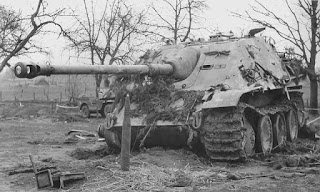 |
| Yeah, hide behind the post, they'll never notice you. ;) |
 |
| That shell hole on the upper left shows what happened. |
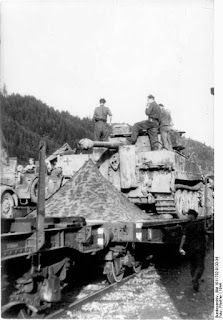 |
| Typical train transport, 1944, crews travel with the tank (Pfeiffer, Federal Archive). |
 |
| A commenter identifies this as Tiger "200" of sPzAbt 503 (heavy tank) in Budapest (Federal Archive). |
 |
| Tiger with some Panzergrenadiers, 1944 (Schodl, Federal Archive). |
 |
| 1943. A commenter identifies this as the 2nd company of sPzAbt 502 in Chateau du Boris du Loup, France (Federal Archive). |
 |
| Getting stuck in gullies was common - they probably figured the little bridge wouldn't support them. Or, this might be a drill, practice at getting out of the mud. |
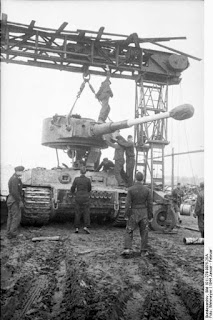 |
| Road gantry Strabokran (Wedermeyer, Federal Archive). |
 |
| The turret is off and ready to repair. It took quite a shot to cause that damage, the crew was fortunate. Note the Strabokran in the distance (Kipper, Federal Archive). |
 |
| SS private (MG squad) chatting with a Romanian officer. |
 |
| There was something about the barrel of a Tiger Tank that proved irresistible to some German soldiers. Actually, here they may be helping to level out the turret to make it easier to get back on (Ang, Federal Archive). |
 |
| German Tiger tank and amphibious Kubelwagon, Spring 1944. (Schack, Federal Archive). |
 |
| King Tiger lying in wait, April 1944 (Luttige, Federal Archive). |
 |
| King Tigers lined up. |
I regularly make corrections/changes to this page. Much of the information on here is not agreed to by all sources, and if you put five "Tiger experts" in a room together, they would come out with ten different "unassailable conclusions" about each fact. Choices must be made about some "facts" and some interpretation drawn in identifying what is going on in the photos. If you see any errors or have other observations that would be helpful to others, kindly leave a note below. I attempt to incorporate changes to make things as accurate as possible. Thank you for reading and for any comments you may have, good or bad (and yes, I get both, but all are welcome).
 |
| Fixing a tank in Russia (Wehmeyer, Federal Archive). |
2019



































































































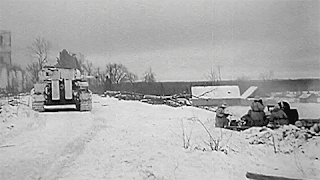







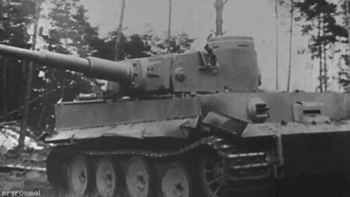




































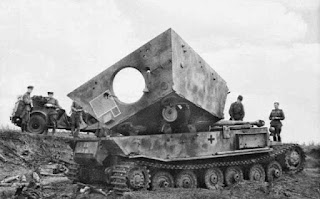







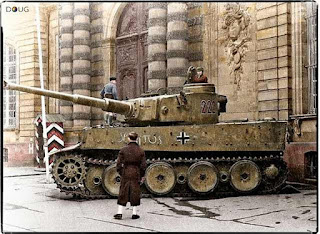




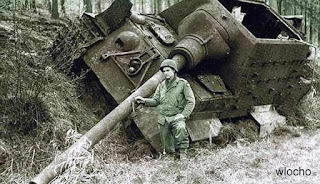








These articles are truly a delight. Well written although the people in the photos are occasionally incorrectly named. I am certain this was mentioned but most people are unaware that there were only around 1300 Tigers built. It is astounding how many tanks the Russians had and in comparison,how few the Germans built.
ReplyDeleteThe 'King Tiger' was certainly, in the Ardennes offensive,unable to effectively maneuver the terrain,so many broke down or were blown up by the Germans…..inadequate fuel etc.
IF the Germans had prioritized the M-262 jet. It was ready for production in 1942, and the 'Sturmgewehr',the first assault rifle, (1943) AND developed 4 engine bombers;they would have won the war. All hypotheticals and hindsight observations.
What hampered the deployment of the Me262 wasn't failure to prioritize it, or even Hitler's supposed insistence that it be developed as ONLY a tactical bomber (in fact, Hitler recognized the CAP capabilities of the design but still insisted on it having hard points for bombs and rockets, a feature which had already proven worthwhile in the Fw190D). The BMW and Jumo jet engines had issues with reliability, as either company could only get 10 (yes, count 'em, TEN) hours before overhaul. Any aircraft design with an engine life of 10 hours TBO won't fly often. Towards the end of the war, figuring out how to tweak the design to get 50 hours (still a miserably brief operational life), but at the cost of excessive fuel consumption (again, the plane doesn't get very far), a relatively FEW of the Me262 made it into front-line service. The Germans lacked for alloys necessary to make a jet engine practical, hence WHY, in a related article on this site, the moderator lampoons Hitler for insisting on holding the Dniepr river line even when it got 58,000 men enciricled (Cherkassy). Hitler was frantic to keep the Nikopol region and squeeze out whatever production of nickel could be had.
ReplyDeleteThe Tiger had been in development since 1937, originally as a "break-through" vehicle, much like the British Infantry tanks (Matilda), the French Char B1, and the Russian KV-1 and KV-2. It 'grew' to nearly twice its original design weight and went from a simple 75mm L24 weapon (the first prototype even used the original PzIV-D turret), only getting the KwK36 once the usefulness of the Flak 88mm in the anti-tank role in Spain and then in France was noted. It was more propagandize than anything else that spurred the development of the Tiger, once the T-34 and KV-1 were encountered in the Soviet Union, the notion that the "Untermensch" could produce a superior tank was intolerable, even though up-gunning the PzIII and PzIV (and producing a StuG III with a long 75mm which probably killed more Soviet tanks than any other German AFV) produced more immediate and widespread results.
ReplyDeleteGuderian was completely against the Panther and Tiger, believing them to be expensive, ponderous, fuel-guzzling, and overrated. Contrary to what was portrayed in otherwise credible productions ("World at War" comes to mind), the actual combat record of the Tiger was far better at Kursk than the Soviets admitted...but as the article points out, there were actually less than 100 participating in that battle. The Germans had already learned that the "break-through" vehicle concept was a dead end and they weren't stupid enough to needless expend their new, expensive toys in that misguided role. Rather, the Tiger made a superior tank hunter even though it was fully considered a 'tank', with its superior long-range firepower and tough armor, especially in the defensive role. By the time enough Tigers were in the front lines, the Wehrmacht was pretty much on the defensive all the time anyway, so by happenstance it was a great vehicle for the job. IMO, the Germans ought to have devoted at least 5% of the Tiger I chassis to the 'Bergepanzer' role, but I'm not aware of any "Bergetigers' other than possibly one field improvisation. Far too many were lost because the beasts were too heavy to be easily moved by the standard recovery tractor.
A "Top Tens" episode on tanks listed the Tiger I as No. 3, with 'Fear Factor' being a reason for its high marks. Considering that the Tiger I looks like an overgrown PzIV (especially with the Schurtzen), it meant that otherwise ordinary medium tanks could scare the crap out of green Allied soldiers. That's the reason why Hitler insisted on the Tiger and he was actually right, it's just that there weren't enough of the beasts and the Panzerwaffe couldn't keep running or fueled those that they had...and at the end, trained and proficient crews, even more important than a good tank itself, were hard to come by.
Very interesting article. Of course one could easily be fascinated by the Tiger I and II but I am more and more convinced that Guderian was right when he was saying that he would prefer an increased production of Panzer IV instead of so few and too much sophisticated tanks like the Tigers. In fact despite his defects due to his rapid development like the Tigers I believe that the Panther remains the best tank made during WW2.
ReplyDeleteRegarding the Schwerer Gustav and Dora 800 mm gun I'm afraid it wasn't any gift from Ferdinand Porsche. The first gun (S.G) was offered to Hitler by Alfried Krupp as it was the custom from the firm for a new gun first exemplary, the second one, Dora was fully charged and paid(7 millions RM). These guns were developped to crush the Maginot Line's forts but were never used against due to the fall of France before their deployment.
ReplyDeleteThank you. I knew one was donated, I mixed them up. Appreciate your comments, very interesting and informative! I have incorporated your contributions into the text. James
Deleteand then please change your misinforming texts in comments of pictures as well. if you need help, then ask...
DeleteThe big guns were used at Sevastopol and Leningrad. In fact, they were extremely helpful when Manstein took Sevastopol in 1942. Probably not necessary, but helpful. As for Leningrad, they seem to have been a waste of time there.
DeleteHello,
ReplyDeleteFascinating article! I did notice that photo 151 (Romanian Officer and Luftwaffe ground trooper), is an SS mann (Private/ Heer Schutz). Note the "SS Eagle" emblem on the left sleeve. He also seems to be part of a MG team, and he has what appears to be a spare MG barrel case slung over his shoulder.
Thank you very much for that insight. I made a change to the caption to reflect that. I'm always impressed by the depth of knowledge readers have about these things. Very humbling, actually. James
DeleteGood Article. In one of the pictures of what is labeled as a KV-1 is actually a KV-2.
ReplyDeleteThe Tiger that you captioned "13./SS-Panzer-Regiment 1 near Petrovka" is actually from s.Pz.Abt.502 at Vaivara, Estonia.
ReplyDeleteGood article. Few comments/corrections to your pictures:
ReplyDelete1. Photo: Tiger tanks and crews in commemorative pose. - That is the newly formed 2nd company of the sPzAbt 502 while in France.
2. Photo: Abandoned (knocked out) Tigers, Villers Bocage - there is one Panzer IV and one Tiger "112" (commander Oscha Ernst) - both knocked out by Sherman Firefly of B Squadron during the battle of Villers Bocage on June 13, 1944.
3. Photo (colored) - PzKpfw IV of SS PzAbt 502 -in Normandy - at that time is SS PzAbt 102.
4. Photo: Soldiers admiring Tigers - that is sPzAbt 507 in an assembly area preparing for an attack on Ternopol in April 1944. Tiger with tactical # A is the battalions headquarter command tank.
5. Photo: Villers Bocage, Summer 1944... - Tiger "231" is getting towed by Tiger "232" (commander SS Untersturmfuehrer Hantusch - is seen in the motorcyclists overcoat).
6. Kurt Knispel - in fact he was a Heer tank commander (never SS) - sPzAbt 503.
7. Tiger II lying in wait - it seems like it's an abandoned Tiger - barrel muzzle is blown off.
8. Photo: One Tiger I got stuck in a ditch - that is the same scene you've alredy correctly described above - mud recovery training in the sPzAbt 503 (Tiger "332")
9. Photo: Infantryman using a destroyed King Tiger for cover - nice picture by the way, kind of rate! That is KT "222" (commander Kurt Sowa) from SS sPzAbt 501 - part of Kampfgruppe Peiper (Ardennes offensive) knocked out in Stavelot.
10. Photo (colored): Michael Wittmann and staff in front of his Tiger. - in fact M.Wittmann (seen from the back in leather coat) was the leader of the 2nd company (Tiger "311" is the 3rd co.).
11. Photo: Looks like Eastern European... - this is commanding Tiger "200" of sPzAbt 503 in Budapest.
12. Photo: 1943, looks like France - this is training area for the 2nd company of sPzAbt 502 in Chateau du Boris du Loup, France.
13. Photo: no comment. Same recovery training of sPzAbt 503 with Tiger "332".
There is a lot of interesting photos without comments (not sure if you intended to make that way or simply have no info?), but it's a lot of work to name it now...
Thank you for your comments! I do appreciate it very much! I have incorporated your observations in the captions. I kind of go back and forth as to how much detail to go into with the captions, sometimes I think the pictures should just speak for themselves. However, I suppose the better course is to be as complete as possible even if it scares away some casual readers. I always try to incorporate helpful information as I have done with yours.
Delete